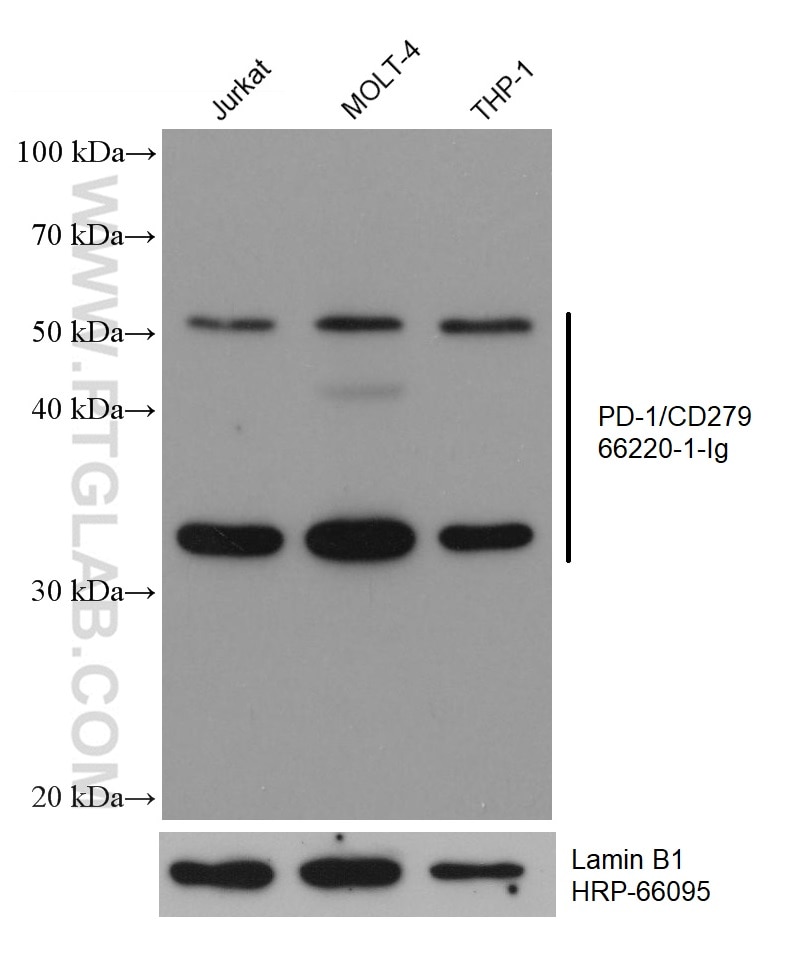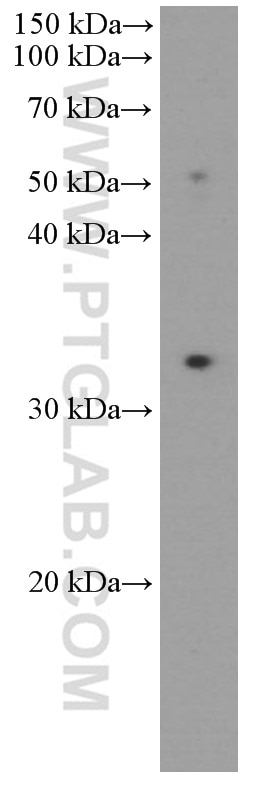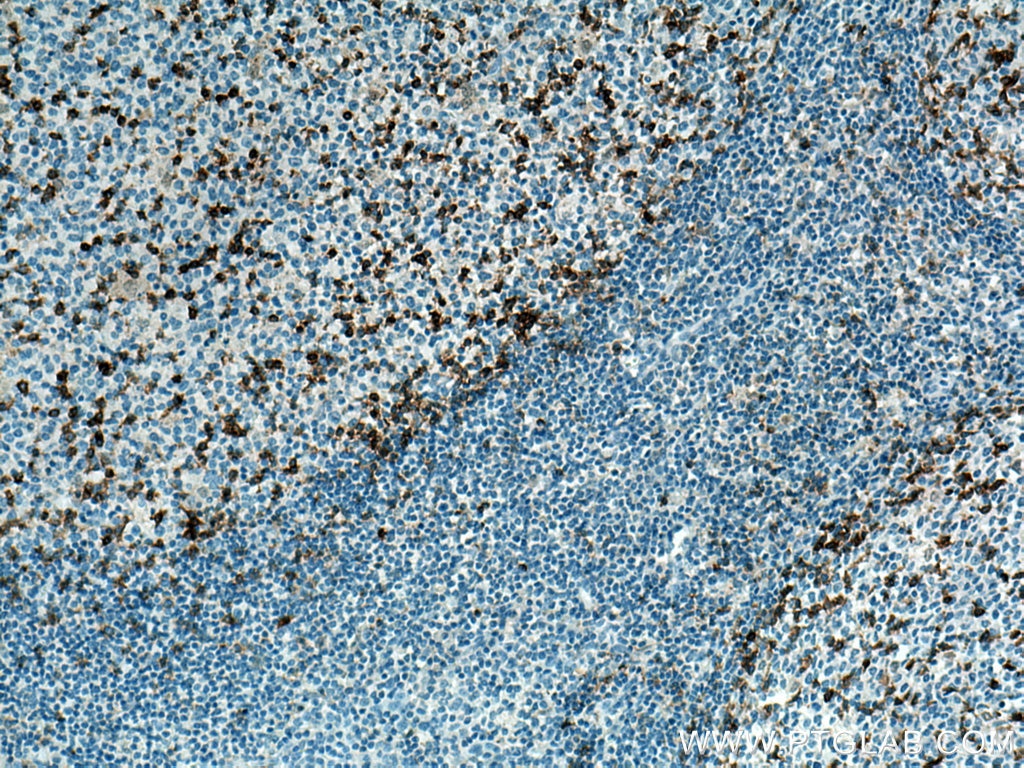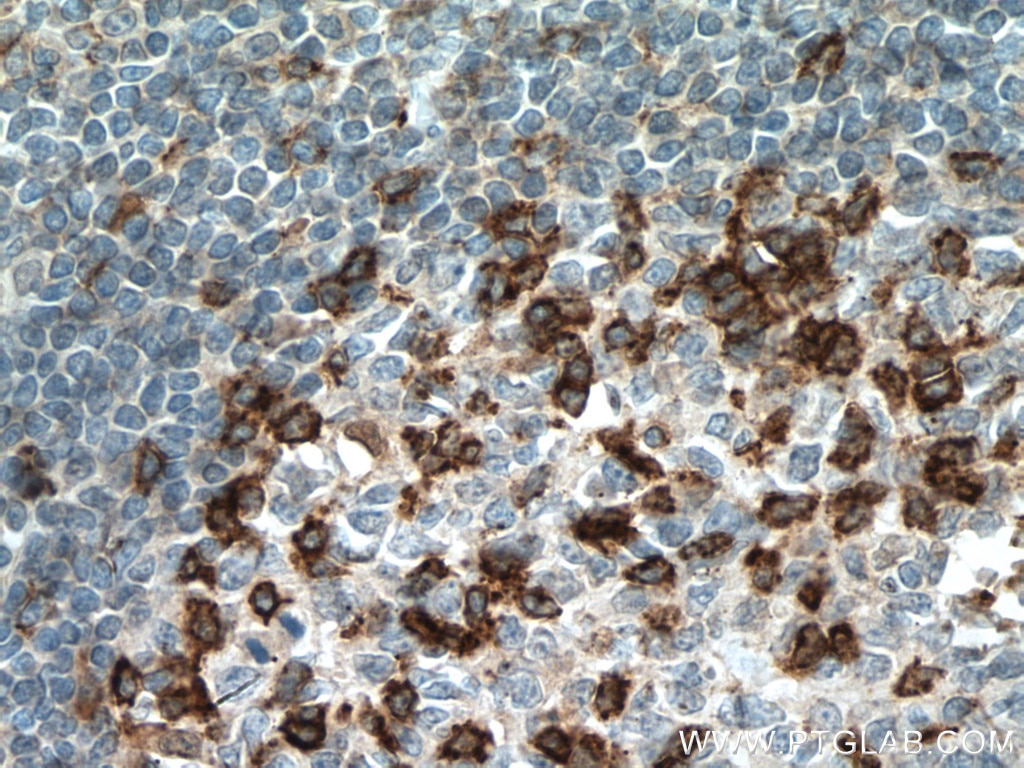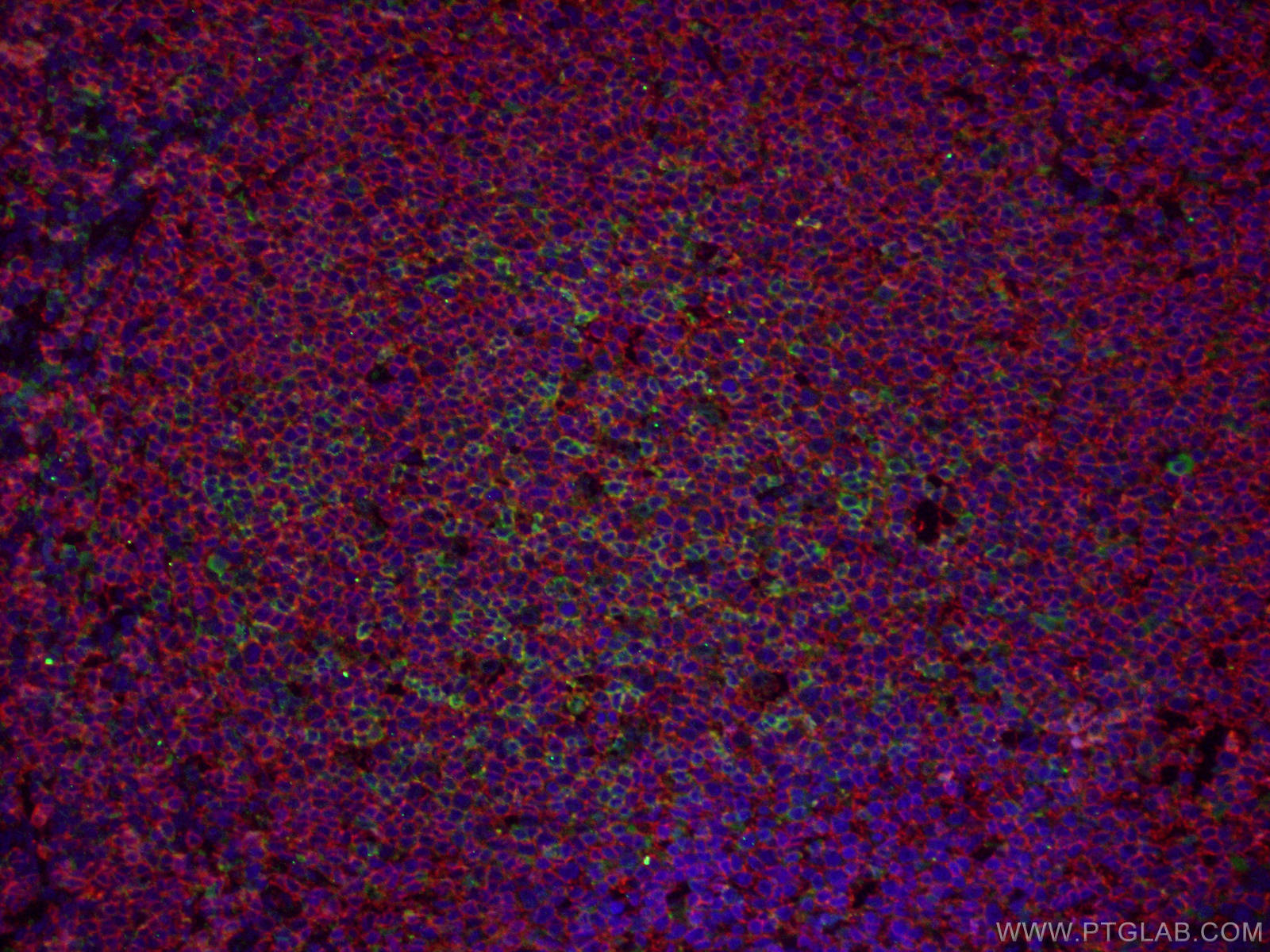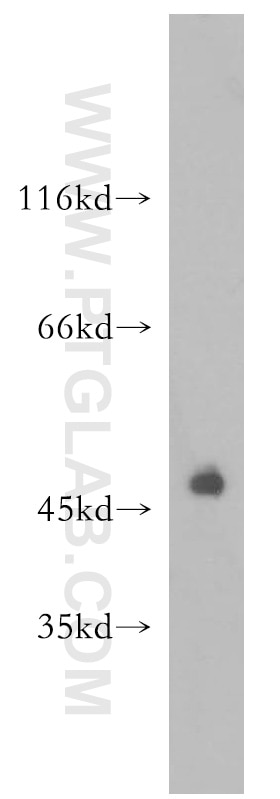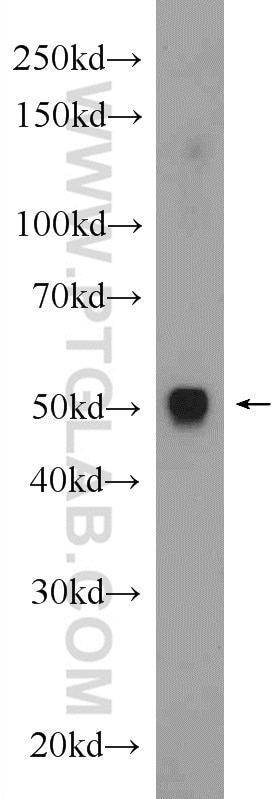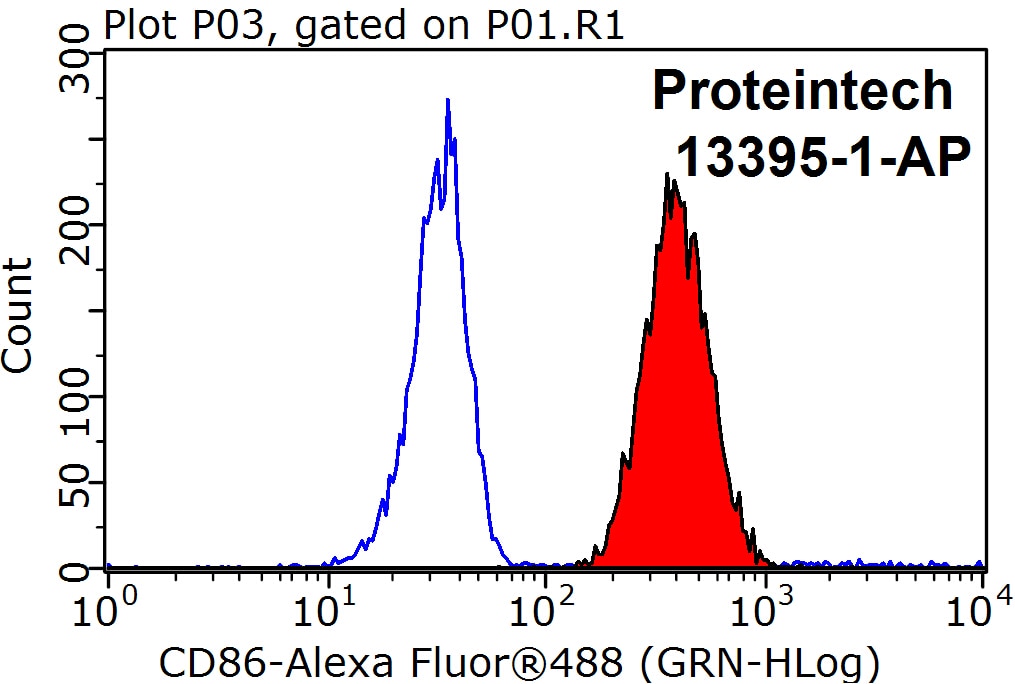Anticorps Monoclonal anti-PD-1/CD279
PD-1/CD279 Monoclonal Antibody for FC, IF, IHC, WB, ELISA
Hôte / Isotype
Mouse / IgG2b
Réactivité testée
Humain, porc, rat, souris
Applications
WB, IHC, IF, FC, ELISA
Conjugaison
Non conjugué
CloneNo.
4H4D1
N° de cat : 66220-1-Ig
Synonymes
Galerie de données de validation
Applications testées
| Résultats positifs en WB | cellules RAW 264.7, cellules Jurkat, cellules MOLT-4, cellules THP-1, tissu de ganglion lymphatique humain, tissu de thymus de porc, tissu de thymus de souris, tissu splénique de rat |
| Résultats positifs en IHC | tissu d'amygdalite humain, tissu de lymphome humain il est suggéré de démasquer l'antigène avec un tampon de TE buffer pH 9.0; (*) À défaut, 'le démasquage de l'antigène peut être 'effectué avec un tampon citrate pH 6,0. |
| Résultats positifs en IF | tissu d'amygdalite humain, |
| Résultats positifs en cytométrie | PMA and ionomycin treated MOLT-4 cells |
Dilution recommandée
| Application | Dilution |
|---|---|
| Western Blot (WB) | WB : 1:5000-1:50000 |
| Immunohistochimie (IHC) | IHC : 1:2000-1:8000 |
| Immunofluorescence (IF) | IF : 1:200-1:800 |
| Flow Cytometry (FC) | FC : 0.20 ug per 10^6 cells in a 100 µl suspension |
| It is recommended that this reagent should be titrated in each testing system to obtain optimal results. | |
| Sample-dependent, check data in validation data gallery | |
Applications publiées
| KD/KO | See 2 publications below |
| WB | See 18 publications below |
| IHC | See 10 publications below |
| IF | See 10 publications below |
| FC | See 1 publications below |
Informations sur le produit
66220-1-Ig cible PD-1/CD279 dans les applications de WB, IHC, IF, FC, ELISA et montre une réactivité avec des échantillons Humain, porc, rat, souris
| Réactivité | Humain, porc, rat, souris |
| Réactivité citée | rat, Humain, souris |
| Hôte / Isotype | Mouse / IgG2b |
| Clonalité | Monoclonal |
| Type | Anticorps |
| Immunogène | PD-1/CD279 Protéine recombinante Ag12470 |
| Nom complet | programmed cell death 1 |
| Masse moléculaire calculée | 288 aa, 32 kDa |
| Poids moléculaire observé | 32 kDa, 47-55 kDa |
| Numéro d’acquisition GenBank | BC074740 |
| Symbole du gène | PDCD1 |
| Identification du gène (NCBI) | 5133 |
| Conjugaison | Non conjugué |
| Forme | Liquide |
| Méthode de purification | Purification par protéine A |
| Tampon de stockage | PBS avec azoture de sodium à 0,02 % et glycérol à 50 % pH 7,3 |
| Conditions de stockage | Stocker à -20°C. Stable pendant un an après l'expédition. L'aliquotage n'est pas nécessaire pour le stockage à -20oC Les 20ul contiennent 0,1% de BSA. |
Informations générales
Programmed cell death 1 (PD-1, also known as CD279) is an immunoinhibitory receptor that belongs to the CD28/CTLA-4 subfamily of the Ig superfamily. It is a 288 amino acid (aa) type I transmembrane protein composed of one Ig superfamily domain, a stalk, a transmembrane domain, and an intracellular domain containing an immunoreceptor tyrosine-based inhibitory motif (ITIM) as well as an immunoreceptor tyrosine-based switch motif (ITSM) (PMID: 18173375). PD-1 is expressed during thymic development and is induced in a variety of hematopoietic cells in the periphery by antigen receptor signaling and cytokines (PMID: 20636820). Engagement of PD-1 by its ligands PD-L1 or PD-L2 transduces a signal that inhibits T-cell proliferation, cytokine production, and cytolytic function (PMID: 19426218). It is critical for the regulation of T cell function during immunity and tolerance. Blockade of PD-1 can overcome immune resistance and also has been shown to have antitumor activity (PMID: 22658127; 23169436). The calculated molecular weight of PD-1 is 32 kDa. It has been reported that PD-1 is heavily glycosylated and migrates with an apparent molecular mass of 47-55 kDa on SDS-PAGE (PMID: 8671665; 17640856; 17003438).
Protocole
| Product Specific Protocols | |
|---|---|
| WB protocol for PD-1/CD279 antibody 66220-1-Ig | Download protocol |
| IHC protocol for PD-1/CD279 antibody 66220-1-Ig | Download protocol |
| IF protocol for PD-1/CD279 antibody 66220-1-Ig | Download protocol |
| FC protocol for PD-1/CD279 antibody 66220-1-Ig | Download protocol |
| Standard Protocols | |
|---|---|
| Click here to view our Standard Protocols |
Publications
| Species | Application | Title |
|---|---|---|
Nat Commun ERK and USP5 govern PD-1 homeostasis via deubiquitination to modulate tumor immunotherapy | ||
Nat Commun m6A mRNA demethylase FTO regulates melanoma tumorigenicity and response to anti-PD-1 blockade. | ||
Cancers (Basel) Overcoming PD-1 Inhibitor Resistance with a Monoclonal Antibody to Secreted Frizzled-Related Protein 2 in Metastatic Osteosarcoma. | ||
Biochem Pharmacol Targeting HMGA1 contributes to immunotherapy in aggressive breast cancer while suppressing EMT | ||
Aging (Albany NY) Elevated lymphocyte specific protein 1 expression is involved in the regulation of leukocyte migration and immunosuppressive microenvironment in glioblastoma. | ||
CNS Neurosci Ther The immunomodulatory effect of microglia on ECM neuroinflammation via the PD-1/PD-L1 pathway. |
Avis
The reviews below have been submitted by verified Proteintech customers who received an incentive forproviding their feedback.
FH Wiesława (Verified Customer) (12-08-2022) | works very well
 |
FH Macarena Lucia (Verified Customer) (10-17-2022) | clear band
|
FH Mona (Verified Customer) (10-17-2021) | Staining of paraffin-embedded lung tissue from hamster. Antigen retrieval was performed with Tris-EDTA (pH 9)
|

